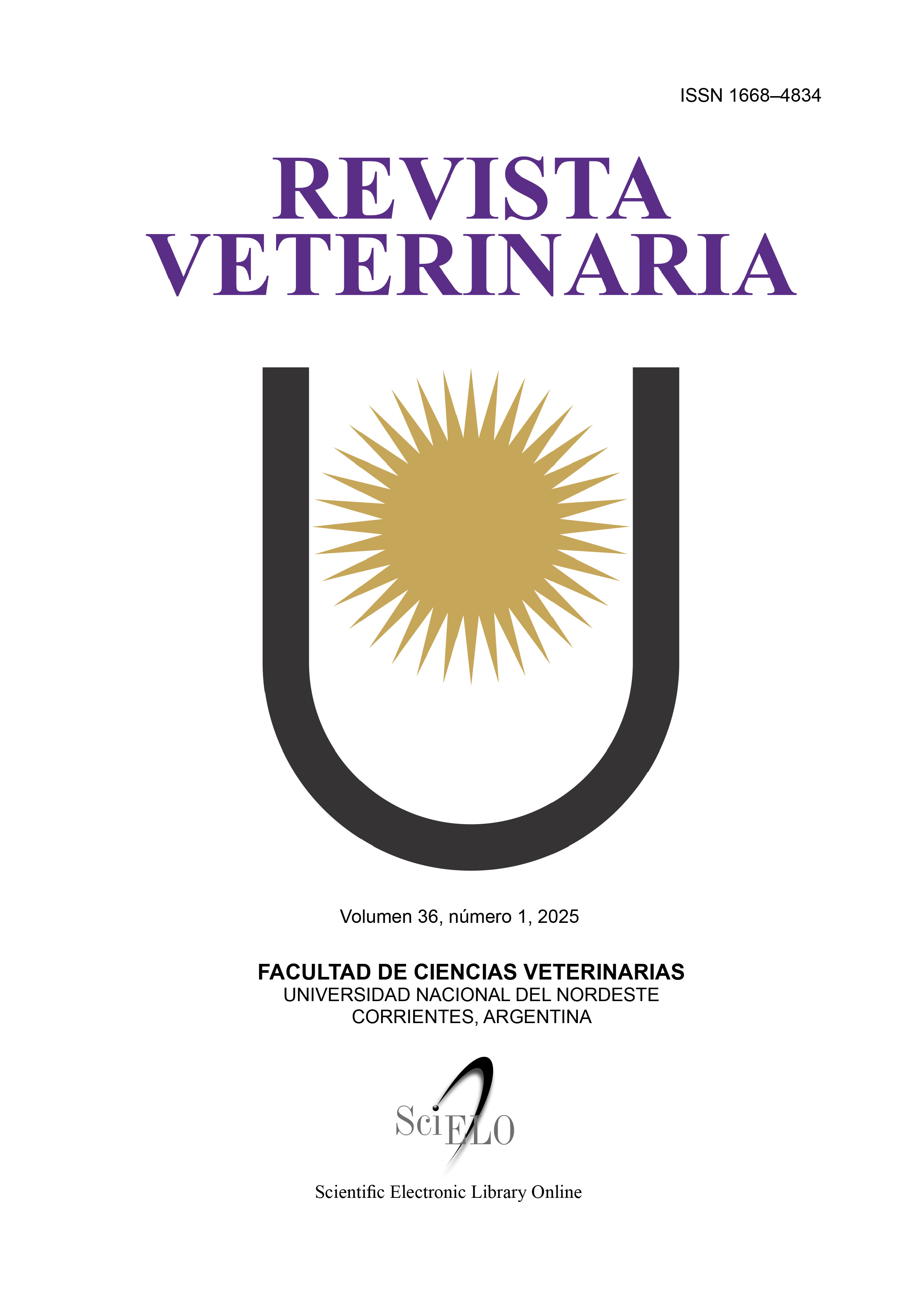Presumptive hypersensitivity pneumonitis in dairy cattle: a case report
DOI:
https://doi.org/10.30972/vet.3628326Palavras-chave:
pneumonia, bovine, hypersensitivity, multinucleated giant cellsResumo
Hypersensitivity pneumonitis is a pathological condition caused by the continuous inhalation of various antigenic compounds, leading to an exacerbated immune response and subsequent lung injury. Although this condition has been reported in several animal species, it has not yet been documented in cattle in South America. This report describes a case that occurred in 2020 on a dairy farm operating under a dry-lot system with soil bedding, located in Buenos Aires province, Argentina. An increased frequency of respiratory cases was observed among lactating cows, occasionally resulting in death. Affected animals exhibited dyspnea, adynamia, orthopneic position, ptyalism, and normal rectal temperature. Postmortem examination of one affected cow revealed severe generalized pulmonary and mediastinal emphysema. Microscopically, mild to moderate thickening of the alveolar septa was observed, accompanied by increased infiltration of lymphocytes, macrophages, and neutrophils. The alveoli contained abundant multinucleated giant cells distributed multifocally, along with occasional macrophages and neutrophils, and multifocal areas of intra-alveolar edema. The interlobular septa were expanded due to lymphatic distension, edema, and a mild diffuse infiltration of macrophages and lymphocytes. Bacteriological cultures were negative. Although parainfluenza-3 virus was isolated from the lung tissue, immunohistochemistry (IHC) results were negative. The epidemiological context, pathological findings, and clinical signs were consistent with hypersensitivity pneumonitis, although its specific etiology could not be determined. Dairy production systems that utilize soil bedding may predispose animals to this condition, even though potential allergens were not assessed in this case. Nonetheless, this clinical and pathological presentation should be considered as a differential diagnosis for respiratory disease under similar production conditions.
Downloads
Referências
Auvermann B, Parker D, Sweeten J. Manure harvesting frequency: the key to feedyard dust control in a summer drought. Agri. Life Extension. 2000; E-52. https://tammi.tamu.edu/files/2014/04/manureharvesting.pdf
Bourke S, Dalphin J, Boyd G, McSharry C, Baldwin C, Calvert J. Hypersensitivity pneumonitis: current concepts. Eur. Respir. J. 2001; 18: 81-92.
Breeze R. Respiratory disease in adult cattle. Vet. Clin. North Am. Food. Anim. Pract. 1985; 1: 311-346.
Carvallo F, Stevenson V. Interstitial pneumonia and diffuse alveolar damage in domestic animals. Vet Path. 2022; 59: 586-601.
Caswell J, Williams K. Chapter 5. Respiratory system. In: Grant Maxie M. editor. Jubb, Kennedy, and Palmer´s Pathology of Domestic Animals: Volume 2. 6th ed. UK; 2015. p. 512-513.
Cebollero P, Echechipía S, Echegoyen A, Lorente M, Fanlo P. Neumonitis por hipersensibilidad (alveolitis alérgica extrínseca). Anales Sis. San. Navarra. 2005; 28: 91-99.
Ellis J. Bovine parainfluenza-3 virus. Vet. Clin. North Am. Food Anim. Pract. 2010; 26: 575-593.
Fink J. Hipersensitivity pneumonitis. J. Allergy Clin. Immunol. 1984; 74: 1-9.
Kawai T, Salvaggio J, Harris J, Arquembourg P. Alveolar macrophage migration inhibition in animals immunized with thermophilic actinomycete antigen. Clin. Exp. Immunol. 1973; 15: 123-130.
Macías-Rioseco M, Mirazo S, Uzal F, Fraga M, Silveira C, Maya L, Riet-Correa F, Arbiza J, Colina R, Anderson ML, Giannitti F. Fetal pathology in an aborted Holstein fetus infected with bovine parainfluenza virus-3 genotype A. Vet Pathol. 2019; 56: 277-281.
McVean D, Franzen D, Keefe T, Bennett B. Airborne particle concentration and meteorologic conditions associated with pneumonia incidence in feedlot cattle. Am. J. Vet. Res. 1986; 47: 2676-2682.
Miller D, Woodbury B. Simple protocols to determine dust potentials from cattle Feedlot soil and surface samples. J. Environ. Qual. 2003; 32: 1634-1640.
Panciera R, Confer A. Pathogenesis and pathology of bovine pneumonia. Vet. Clin. Food Anim. Pract. 2010; 26: 191-214.
Sharma O. Hypersensitivity pneumonitis: a clinical approach. In: Herzog H, ed. Progress in respiration research. Basel, Karger, 1989. p. 1-10.
Spagnolo P, Rossi G, Cavazza A, Bonifazi M, Paladini I, Bonella F, Sverzellati N, Costabel U. Hypersensitivity pneumonitis: a comprehensive review. J. Invest. Allergol. Clin. Immunol. 2015; 25: 237-250.
Stöber M. Reacciones de sensibilidad de bronquios y pulmones. Medicina Interna y Cirugía del Bovino. Editorial Intermédica. 4° ed. 2005. P. 313-314.
Sweeten J, Parnell C, Etheredge R, Osborne D. Dust emissions in cattle feedlots. Vet. Clin. North Am. Food Anim. Pract. 1988; 4: 557-578.
Van Metre D. Allergic respiratory disease. Vet. Clin. North Am. Food Anim. Pract. 1997; 13: 495-514.
Weber S, Kullman G, Petsonk E, Jones W, Olenchock S, Sorenson W, Parker J, Marcelo-Baciu R, Frazer D, Castranova V. Organic dust exposures from compost handling: case presentation and respiratory exposure assessment. Am. J. Ind. Med. 1993; 24: 365-374.
Wilkie B. Hypersensitivity pneumonitis: experimental production in calves with antigens of Micropolyspora faeni. Can. J. Comp. Med. 1976; 40: 221-227.
Wilkie B. Bovine allergic pneumonitis: an acute outbreak associated with mouldy hay. Can. J. Comp. Med. 1978; 42: 10-15.
Wiseman A, Dawson C, Pirie H, Breeze R, Selman I. The incidence of precipitins to Micropolyspora faeni in cattle fed hay treated with an additive to suppress bacterial and mould growth. J. Agric. Sci. 1973; 81: 61-64.
Wiseman A. Influence of environment on respiratory disease. In: Respiratory diseases in cattle: a Seminar in the EEC Programme of Coordination of Research on Beef Production held at Edinburgh. 1978; 149-157.
Downloads
Publicado
Como Citar
Edição
Seção
Licença

Este trabalho está licenciado sob uma licença Creative Commons Attribution-NonCommercial 4.0 International License.
Política de acceso abierto
Esta revista proporciona un acceso abierto inmediato a su contenido, basado en el principio de que ofrecer al público un acceso libre a las investigaciones ayuda a un mayor intercambio global de conocimiento. La publicación por parte de terceros será autorizada por Revista Veterinaria toda vez que se la reconozca debidamente y en forma explícita como lugar de publicación del original.
Esta obra está bajo una licencia de Creative Commons Reconocimiento-NoComercial 4.0 Internacional (CC BY-NC 4.0)










.jpg)
.jpg)



